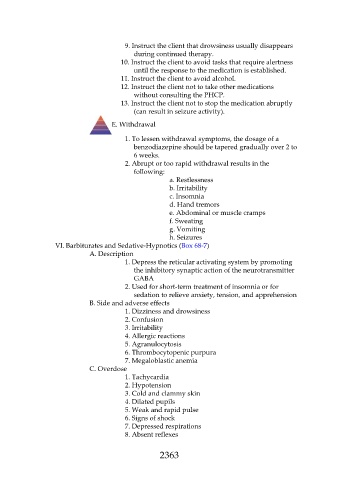Page 2363 - Saunders Comprehensive Review For NCLEX-RN
P. 2363
9. Instruct the client that drowsiness usually disappears
during continued therapy.
10. Instruct the client to avoid tasks that require alertness
until the response to the medication is established.
11. Instruct the client to avoid alcohol.
12. Instruct the client not to take other medications
without consulting the PHCP.
13. Instruct the client not to stop the medication abruptly
(can result in seizure activity).
E. Withdrawal
1. To lessen withdrawal symptoms, the dosage of a
benzodiazepine should be tapered gradually over 2 to
6 weeks.
2. Abrupt or too rapid withdrawal results in the
following:
a. Restlessness
b. Irritability
c. Insomnia
d. Hand tremors
e. Abdominal or muscle cramps
f. Sweating
g. Vomiting
h. Seizures
VI. Barbiturates and Sedative-Hypnotics (Box 68-7)
A. Description
1. Depress the reticular activating system by promoting
the inhibitory synaptic action of the neurotransmitter
GABA
2. Used for short-term treatment of insomnia or for
sedation to relieve anxiety, tension, and apprehension
B. Side and adverse effects
1. Dizziness and drowsiness
2. Confusion
3. Irritability
4. Allergic reactions
5. Agranulocytosis
6. Thrombocytopenic purpura
7. Megaloblastic anemia
C. Overdose
1. Tachycardia
2. Hypotension
3. Cold and clammy skin
4. Dilated pupils
5. Weak and rapid pulse
6. Signs of shock
7. Depressed respirations
8. Absent reflexes
2363

